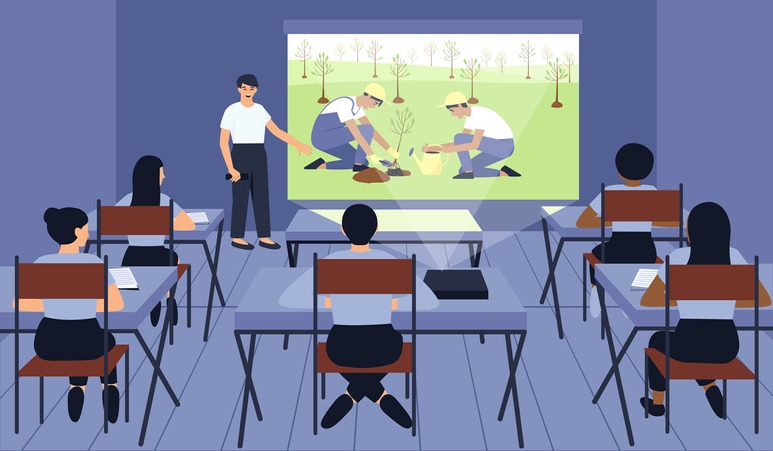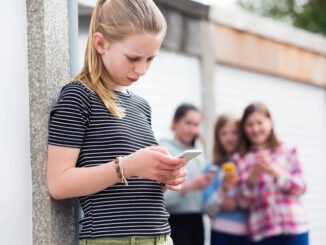
Video content is a popular medium for classroom teaching, but it isn’t without its issues – Michael Wilkinson and Tiffanie Harris discuss how to use it safely in the classroom
CREDIT: This is an edited version of an article that originally appeared on ASCL
The use of video-related content in classroom teaching is becoming an ever more popular way to engage children and young people in their learning, whilst also allowing them to follow up further at home in a medium that is increasingly accessible.
Michael Wilkinson spent over 20 years working in education before taking up the role of MD of ASCL Premier Partner ClickView UK. In a recent Primary Podcast, he spoke about the benefits of video content to teaching and learning and in this blog, this discussion will be taken further.
In the podcast, Wilkinson highlights three significant issues relating to the use of videos and online content in schools:
- Workload
- Safeguarding
- Legalities
Children spent on average three hours and 18 minutes per day watching television programmes.
In the podcast, they discussed the above statistic from Ofcom’s Children and parents: media use and attitudes report (2021).
The statistics go on to suggest that “children spent more time watching content (programmes, video and short clips) in 2020 than they did in 2019 (from 2 hours 54 minutes to 3 hours 18 minutes in 2020).”
Wilkinson believes we could use part of this ‘screen time’ for the benefit of learning and education. He adds that teachers are increasingly using videos as a ‘de facto’ resource in classroom teaching, as was also the case before lockdown, due to, amongst many other reasons, the ease of access and use for students.
What are the issues?
Workload
Teachers spend a lot of planning time identifying safe, suitable, age-appropriate resources and this eats significantly into teacher time. The recently published DfE report Working Lives for Teachers and Leaders – Wave 1 highlights the many pressures on workload and teacher time, with 48% of their survey stating they spent ‘too much’ time on lesson planning.
When looking for resources, for many teachers, YouTube is the ‘go-to’ place. YouTube has some fantastic content, but this can add to the workload. To illustrate part of the challenge, for example, a search for ‘verbs’ on YouTube will display a list of 28 million. More specifically, a search of ‘Key Stage 1 verbs’ also provides over 2 million results – which one of those is the best to use?
Topics such as ‘sustainability’ also yield impossibly high search results, still requiring hours of work to find suitable resources. As with such content, teachers really need to watch the entire clip, vetting for suitability for their learners, particularly if researching a topic such as ‘puberty’.
Productivity time is being wasted in transforming the learning environment of the classroom before the lesson planning and outcomes have even started, and even then, videos are subject to adverts which impact students’ focus and attention.
Compounding this challenge, teachers express frustration with content disappearing, leading to a lack of confidence in locking into longer-term planning.
Safeguarding
Having already invested time vetting content for safeguarding and suitability, the challenge is further complicated when considering independent access and out-of-school learning.
The same Ofcom research report highlights the statistic that “29% have seen worrying or nasty content online (aged 8-15s who go online in England).”
The importance of children and young people having their own logins to use outside of school so they can continue to access safe and age-appropriate videos supports parents and carers in giving them confidence there will be no unwanted adverts and, essentially, no safeguarding distractions. And of course, it is also worth a reminder that YouTube’s own T&Cs state users must be a minimum of 13 years old to use the platform.
Extensive guidance and resources for education professionals, parents, grandparents and carers and children and young people are provided by the UK Safer Internet Centre, including information on how to report harmful content.
Legalities
Many teachers are taking to use their personal video streaming services accounts. Films, documentaries, drama and news are powerful tools for capturing students’ attention, providing sensory experiences and really bringing learning to life, so much so, that the DfE funds a licence (the ERA licence) for all state schools to legally use TV content for educational purchases.
Using personal accounts is clearly limited to in-class use which limits its potential, however, the major issue here is the terms of most streaming services do not legally permit this use. The recent password-sharing cases from Netflix also highlight this with regards to personal streaming, let alone broadcasting to wider audiences.




Be the first to comment